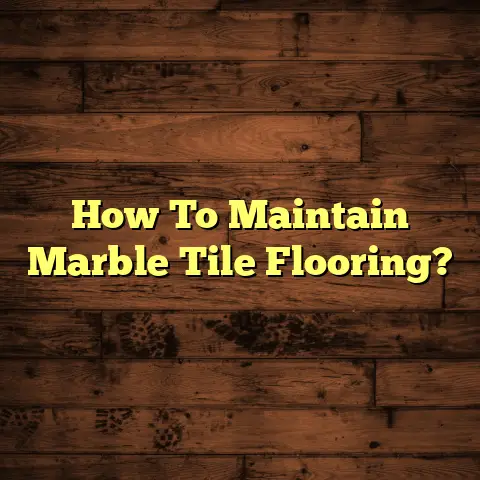Laminate Water Resistance: Guide? (1 Mistake = Ruin!)
Trust me, when it comes to laminate, one little slip-up with water can turn your dream floor into a soggy nightmare.
Laminate flooring has become super popular, right?
It’s affordable, looks great, and there are tons of styles to choose from.
Plus, with all the eco-friendly tech these days, you can even find sustainable options.
But here’s the deal: laminate and water aren’t exactly best friends.
While some types are more water-resistant than others, one wrong move during installation or maintenance, and BAM!
You’re dealing with swelling, warping, and a whole lot of frustration.
So, let’s dive into the world of laminate water resistance, learn how to avoid common pitfalls, and keep your floors looking fantastic for years to come.
Section 1: Understanding Laminate Flooring
Okay, so what is laminate flooring, exactly?
Think of it as a multi-layered sandwich, each layer playing a crucial role:
Wear Layer: This is the top layer, the one you walk on.
It’s a clear, protective coating that resists scratches, stains, and fading.Design Layer: This is where the magic happens!
A high-resolution image of wood, stone, or tile is printed on this layer, giving laminate its realistic appearance.Core Layer: This is the heart of the laminate, usually made of high-density fiberboard (HDF) or medium-density fiberboard (MDF).
It provides stability and impact resistance.-
Backing Layer: The bottom layer, which provides a moisture barrier and helps to balance the floor.
Manufacturing and Eco-Friendliness:
The manufacturing process involves bonding these layers together under high pressure and heat.
More and more manufacturers are using eco-friendly practices, like using recycled materials for the core layer and water-based inks for the design layer.
This is great, because it means you can have beautiful floors without harming the planet!
Why Choose Laminate?
I get asked this a lot, and here’s what I tell people:
-
Cost-Effective: Laminate is generally cheaper than hardwood or tile, making it a budget-friendly option.
Design Versatility: Seriously, the options are endless.
You can find laminate that looks like almost any type of wood, stone, or tile.Easy Installation: Most laminate flooring uses a click-lock system, making it a DIY-friendly project.
I’ve seen homeowners tackle entire rooms in a weekend!
Section 2: The Importance of Water Resistance in Laminate Flooring
Why is water resistance such a big deal?
Well, think about where you might install laminate:
Kitchens: Spills happen, right?
Whether it’s a dropped glass of juice or an overflowing sink, your kitchen floor is bound to get wet.-
Bathrooms: Humidity, splashes from the shower, leaky toilets… bathrooms are a water resistance battleground.
Basements: Basements are notorious for moisture issues.
Without proper protection, your laminate floor could be in trouble.
Water Resistance Ratings:
This is where things get a little technical, but it’s important to understand.
Laminate flooring is often rated for water resistance based on testing standards like the NALFA LF-01.
These tests measure how well the laminate withstands water exposure over a certain period.
The higher the rating, the better the water resistance.
It’s worth noting that there isn’t a single universal rating system, so it’s essential to check the manufacturer’s specifications for the specific product you’re considering.
Section 3: Types of Water Resistance in Laminate Flooring
Let’s clear up a common misconception: water-resistant is not the same as waterproof.
Water-Resistant vs. Waterproof:
Water-Resistant: This means the flooring can withstand moisture for a short period.
Spills need to be cleaned up quickly, and prolonged exposure to water can still cause damage.Waterproof: This means the flooring is completely impervious to water.
It can be submerged without damage.
While some laminate floors are highly water-resistant, truly waterproof laminate is rare.
Technologies for Enhanced Water Resistance:
Manufacturers use various technologies to boost water resistance. Here are a few examples:
-
AquaBloc: This technology involves a tight-locking system and a water-resistant coating on the edges of the planks, preventing water from seeping through the seams.
-
HydroGuard: Similar to AquaBloc, HydroGuard focuses on sealing the edges and surface of the laminate to keep water out.
-
Waterproof Core: Some laminate floors use a special core material that is more resistant to water absorption than standard HDF or MDF.
Leading Brands and Their Features:
Pergo: Pergo is a well-known brand that offers several water-resistant laminate options.
Their WetProtect technology provides a lifetime waterproof warranty on select products.-
Mohawk: Mohawk’s RevWood line features Hydroseal coating, which provides excellent water resistance.
-
Shaw Floors: Shaw’s Repel Water Resistant Technology is designed to prevent everyday spills and messes from damaging the floor.
Section 4: Common Mistakes That Compromise Water Resistance
Alright, let’s get to the meat of the matter: the mistakes that can ruin your laminate floor.
I’ve seen these happen time and time again, and trust me, they’re easily avoidable!
Mistake #1: Poor Installation Practices
This is HUGE. Proper installation is the foundation of water resistance.
Inadequate Sealing: Those seams between the planks?
They’re vulnerable to water penetration.
Make sure they’re tightly locked and consider using a sealant specifically designed for laminate flooring in high-moisture areas.Improper Acclimation: Laminate needs to adjust to the humidity levels in your home before installation.
If you skip this step, the planks can expand or contract after installation, creating gaps where water can seep in.
I recommend following the manufacturer’s guidelines, which usually involve storing the unopened boxes in the room where they’ll be installed for at least 48-72 hours.
Mistake #2: Choosing the Wrong Underlayment
Underlayment is the layer between the subfloor and the laminate.
It provides cushioning, sound insulation, and, most importantly, a moisture barrier.
- Lack of Moisture Barrier: If your underlayment doesn’t have a built-in moisture barrier, you’re basically inviting water damage.
Look for underlayment specifically designed for laminate flooring that includes a polyethylene or similar moisture-resistant film.
Mistake #3: Neglecting to Maintain Proper Humidity Levels in the Home
Excessive humidity can wreak havoc on laminate flooring.
High Humidity: When humidity levels are too high, the laminate can absorb moisture from the air, causing it to swell and warp.
I recommend maintaining a humidity level between 30% and 50%.
Use a dehumidifier in damp areas like basements and ensure proper ventilation in bathrooms and kitchens.According to the EPA, maintaining indoor humidity between 30-50% can also reduce mold growth.
Mistake #4: Using Excessive Water During Cleaning or Using the Wrong Cleaning Products
Laminate is not a fan of excessive moisture.
Soaking the Floor: Avoid using a soaking wet mop.
Instead, use a damp mop or a microfiber cloth.Harsh Cleaners: Avoid using abrasive cleaners, bleach, or ammonia-based products.
These can damage the wear layer and make the laminate more susceptible to water damage.
Stick to cleaners specifically designed for laminate flooring.
Real-Life Scenario:
I once had a client who installed beautiful laminate flooring in their basement.
They skipped the moisture barrier underlayment, thinking it wasn’t necessary.
A few months later, a small leak in their washing machine went unnoticed for a couple of days.
The laminate absorbed the water like a sponge, causing it to buckle and warp.
The entire floor had to be replaced, costing them thousands of dollars.
Section 5: Identifying and Repairing Water Damage in Laminate Flooring
Okay, so you suspect your laminate might have water damage. What now?
Signs of Water Damage:
-
Warping: The planks start to curve or bend upwards.
-
Buckling: The planks lift up from the subfloor, creating an uneven surface.
-
Discoloration: The laminate changes color, often becoming darker or developing a yellowish tint.
-
Swelling: The edges of the planks become thicker than the center.
-
Mold or Mildew: You might notice a musty odor or see visible mold growth, especially in damp areas.
Steps to Take If You Suspect Water Damage:
-
Identify the Source: Find the source of the water leak and fix it immediately.
-
Dry the Area: Use towels, fans, and a dehumidifier to dry the affected area as quickly as possible.
-
Assess the Damage: Carefully inspect the laminate for signs of warping, buckling, or discoloration.
Repairing or Replacing Damaged Sections:
If the damage is minor, you might be able to repair it.
Replacing Individual Planks: If only a few planks are damaged, you can replace them.
Use a utility knife to carefully score around the damaged plank and remove it.
Clean the subfloor and install a new plank, making sure it clicks securely into place.Addressing Underlying Moisture Issues: Before replacing any planks, make sure to address the underlying moisture issues.
This might involve repairing a leaky pipe, improving ventilation, or installing a vapor barrier.
If the damage is extensive, you might need to replace the entire floor.
This is a bigger project, but it’s often the best solution for severe water damage.
Section 6: Preventing Water Damage in Laminate Flooring
Prevention is always better than cure, right?
Here are some best practices to keep your laminate floors safe from water damage:
Proper Installation Techniques: Hire a professional installer or follow the manufacturer’s instructions carefully.
Pay close attention to sealing the seams and acclimating the flooring.-
Selecting the Right Products and Materials: Choose water-resistant laminate flooring and a moisture-barrier underlayment.
Regular Maintenance and Cleaning Routines: Clean up spills immediately and avoid using excessive water when mopping.
Use a cleaner specifically designed for laminate flooring.-
Monitoring Humidity Levels in the Home: Use a hygrometer to monitor humidity levels and take steps to control excessive humidity.
Using Moisture Barriers and Proper Underlayment in Installations: This is so important that it bears repeating.
Always use a moisture barrier underlayment, especially in basements and bathrooms.
Personal Story:
I remember a time when I was installing laminate in a client’s kitchen.
They were on a tight budget and wanted to skip the moisture barrier underlayment.
I strongly advised against it, explaining the risks of water damage.
They eventually agreed, and a few months later, a pipe burst under their sink.
The moisture barrier saved their laminate floor from complete destruction.
They were so grateful that they had listened to my advice!
Conclusion
So, there you have it: the ultimate guide to laminate water resistance.
I hope I’ve made it clear that while laminate can be a fantastic flooring choice, understanding its limitations when it comes to water is crucial.
One mistake, whether it’s a rushed installation, a forgotten moisture barrier, or a cleaning mishap, can indeed lead to catastrophic damage.
But don’t let that scare you off!
By being informed, proactive, and following the tips I’ve shared, you can enjoy the beauty and affordability of laminate flooring for years to come.
Remember to choose the right products, install them correctly, maintain them properly, and always be mindful of moisture.
Your floors (and your wallet) will thank you for it!
Now, go forth and create beautiful, water-resistant laminate floors!





